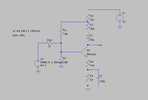throbscottle
Well-Known Member
I've been playing with a 1 transistor amplifier in LTSpice. Trying to get a flat response from DC to some high frequency. Why is it that whatever I do, the response starts to roll off around 20 - 30MHz? I've put in a BFR181, specced for broadband use, but still starts to roll off at the same point. Trying to push it further with capacitors and/or inductors produces a hump at the high end with little improvement in bandwidth.
I also tried straight and folded cascode versions. It's a bit better, but the change in response still happens in approximately the same place. Only the degree of change is different. Same with trying different transistors. They roll off different amounts, but it's around the same place.
What's the secret?
I also tried straight and folded cascode versions. It's a bit better, but the change in response still happens in approximately the same place. Only the degree of change is different. Same with trying different transistors. They roll off different amounts, but it's around the same place.
What's the secret?



